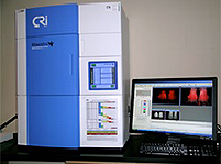Benefits of Fluorescence Imaging
• Multi-animal, high-throughput studies at relatively low cost
• Quantitative measurements
• High signal sensitivity
• Fluorescence probes, which can be activatable, are commercially available
• Multiple probes/targets can be imaged simultaneously
• No ionizing radiation
Ideally Suited For
• Cancer research, drug discovery and studies of inflammation, infectious diseases
Not Suited For
• High resolution imaging
Disadvantages
• Low resolution
• Tissue autofluorescence can increase background
• Less translational to clinic than microPET, microSPECT, MRI
• Depth of penetration of excitation and emitted light can be limiting
Ivis Spectrum
The IVIS Spectrum (Perkin Elmer) is a state-of-the-art high sensitivity optical imaging system for in vivo small animal studies using fluorescent reporter genes or injectable fluorescence contrast agents. All images are captured by a thermoelectrically cooled back-thinned, back-illuminated CCD camera, with a 2048 x 2048 array of 13.5 micron pixels (27 x 27 mm total area) and a 16-bit digitizer using 6-inch diameter optics with f-stop values that can be varied from f/1 to f/8. A computer-controlled filter wheel with 18 narrow-band (20 nm bandwidth) emission filters provide wavelength selectivity in the range 490-850 nm. A high intensity broad-band excitation source is filtered by one of ten computer-selectable excitation filters with bandwidths of 30 nm and covering an excitation range of 415-760 nm. The fluorescence light is delivered via an open fiber and can illuminate the subject in either reflective (epi-illumination) or transmission mode by selecting the appropriate fiber bundle switch. The system provides four levels of magnification ranging from high (20 micron) resolution (for single cell in vitro imaging) to a lower magnification, wide field setting, that allows imaging of 5 mice simultaneously.
Maestro 2
The Maestro 2 (CRi) is a high-performance system designed for in vivo measurement of fluorescence signals in small animals. It is distinguished by its multispectral imaging capability, which allows for imaging several fluorophore contrast agents simultaneously. Seven excitation and seven emission filters are available to allow multiple excitation/emission combinations for differentiating a wide range of fluorophores from blue to near-infra red wavelengths. Spectral curves for each fluorophore as well as for autofluorescence can be generated and saved into a spectral library. Using a spectral library, spectral decomposition of several fluorophores and autofluorescence is achieved. The autofluorescence component is thus removed and provides individual curves for each fluorophore. By using contrasting, artificial coloration for each spectral curve, a composite image is obtained with the locations of the fluorophores displayed in distinctly different colors. The enhanced signal-to-noise ratio allows imaging of smaller or fainter signals from molecular targets than is possible with systems that cannot eliminate autofluorescence. Regions of interest can be delineated manually or by threshold segmentation for quantitative analysis of images. The Maestro is equipped for inhalation (isoflurane) anesthesia and the chamber and animal stage are heated to maintain a stable body temperature while the animal(s) are in the chamber. Up to three animals can be imaged simultaneously and imaging times are typically on the order of a few seconds, thus providing a potentially high-throughput imaging system. Although intended as a planar imaging system, limited 3-D positional information can be acquired using a multiview platform with side mirrors to generate simultaneous lateral views in addition to the dorsal or ventral view.


